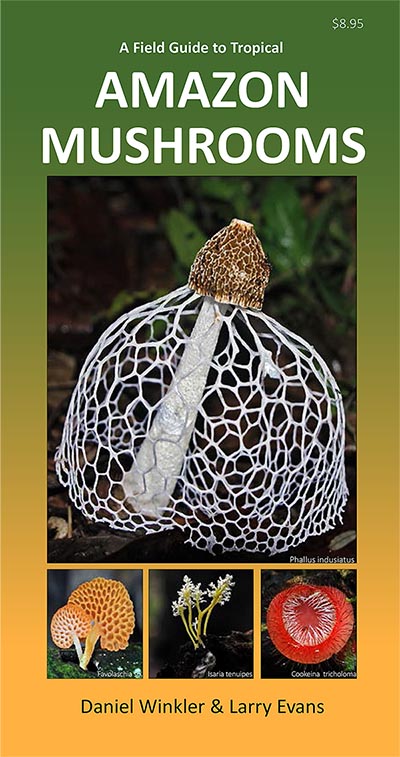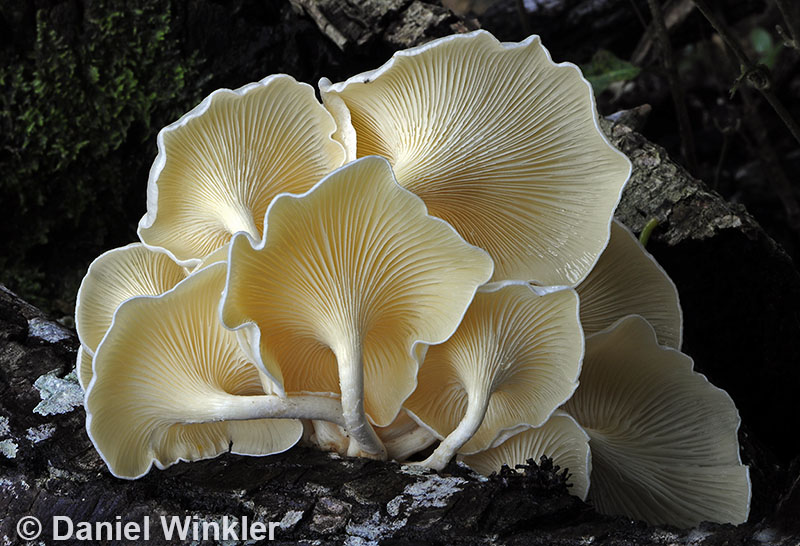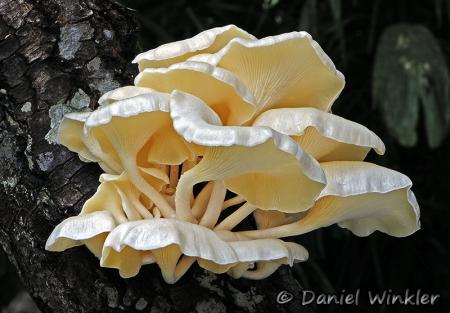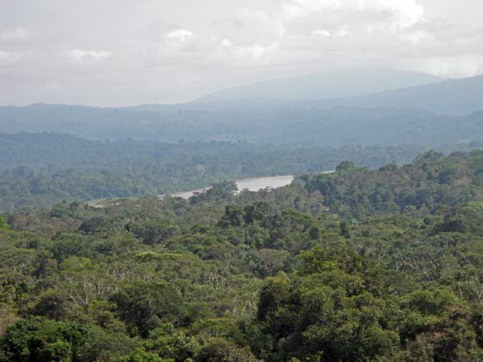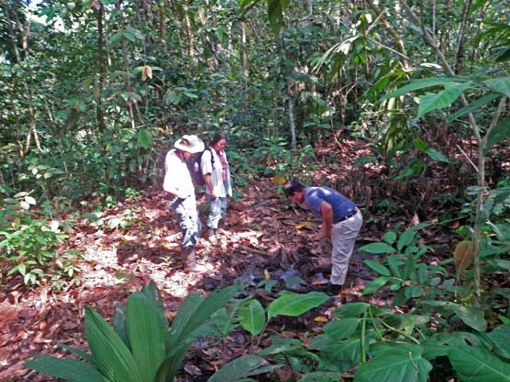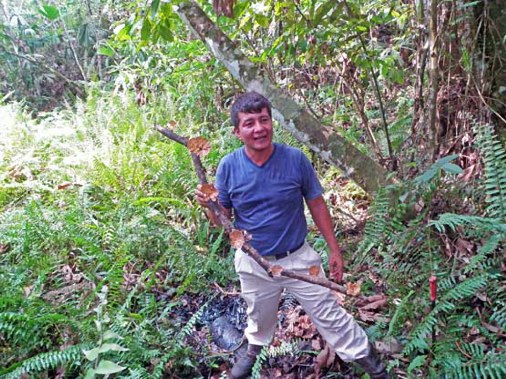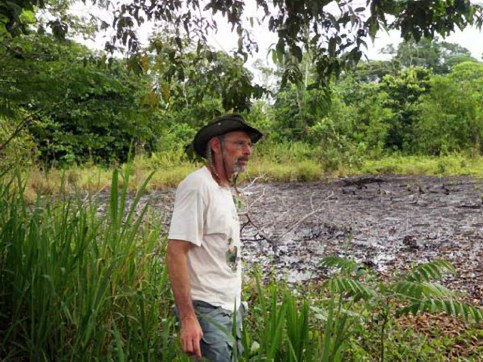Upcoming: MushRoaming Colombia April 22 to May 5, 2023
Article on our Ecuador trip in Feb. 2011 Itinerary with detailed species list Ecuador 2011
|
Amazing Amazon
Funga, Flora & Fauna Pictures from MushRoaming Ecuador & Bolivia
Enjoy!
(all photos © Daniel Winkler unless otherwise stated) Funga - Mushrooms
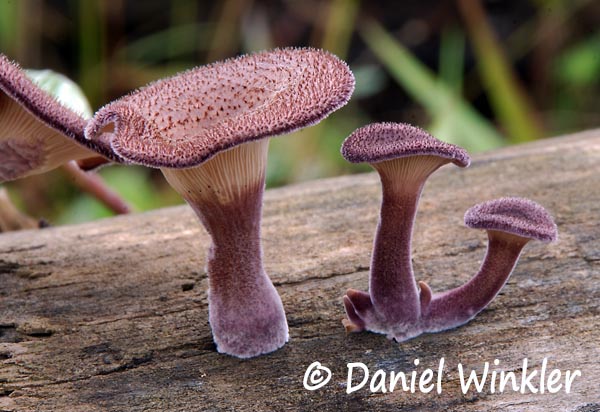 A beautiful purple Panus neostrigosus (aka. P. lecomtei, and Lentinus strigosus), the Bristled Sawgill or a species very close to it. In Northern America Panus lecomtei a.k.a. Panus rudis grows on dead hardwood just as this mushroom does in the Amazon. When young the purplish coloration of Panus lecomtei is much more pronounced, with age the color fades.
It is also edible and is being cultivated. Here a link to an article looking into nutrient content depending on substrate.
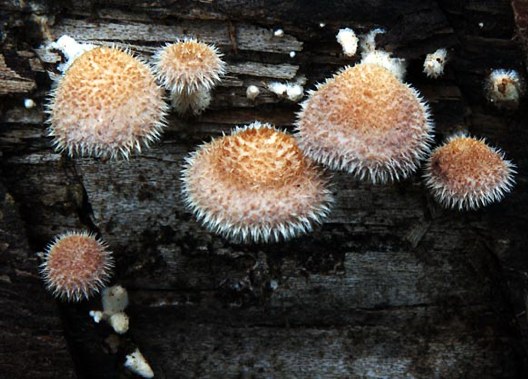 Lentinus crinitus, the Fringed Sawgill is a beautiful mushroom with an impressive coiffure. It is also an edible. The image above shows mature specimens. Although superficially it could be assumed to be related to Shiitake mushrooms (Lentinula edodes, Marasmiaceae, Agaricales). However Lentinus crinitus is a member of the Polyporaceae, Polyporales, which have only a few gilled mushrooms among them.
|
The convenient, light-weight, pocket-sized, laminated field guide contains images and brief descriptions of over 80 fungi, including their ecological niches and human uses. Over 20 of these mushrooms are unique to the Amazon, over 50 are found from Mexico to Argentina, and almost as many are found in other tropical zones around the world. This booklet offers a visual way to identify the most commonly encountered mushrooms with special attention to the most stunning and best edible Amazon mushrooms.
NEW! Updated Spanish language version available!
Versión actualizada en idioma español Guía de Campo de los Macrohongos de la Region Amazónica, 2023 Below the Cordyceps page
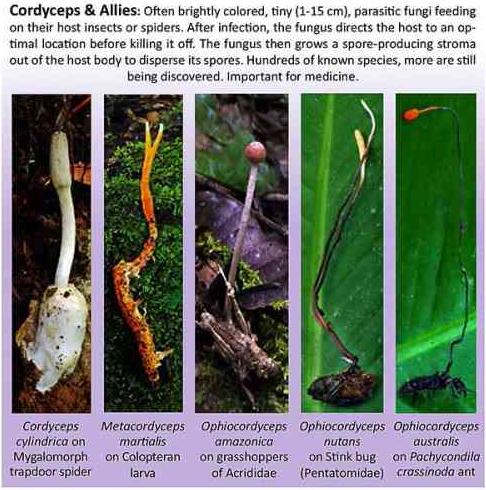 |
|
Stinkhorns and other aliens from the Phallaceae
|
|
|
_
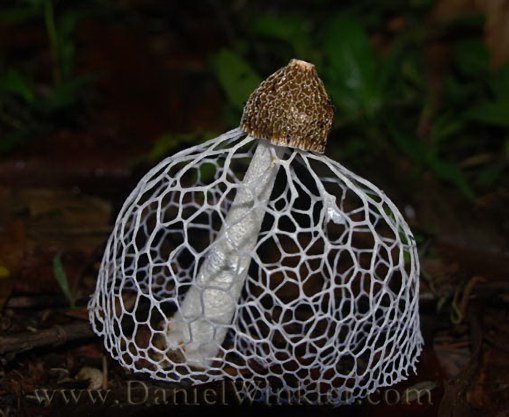 While on a night walk we found many Veiled stinkhorns, Phallus indusiatus [the former Dictyophora indusiata seems to be out again after DNA research]. They just had come up, ready for the Amazonian night life. Insects and most of the other creatures are active at night so the stinkhorn shares its stinky spores at night. The morning after, the party is over, all spores are gone and the horn is flaccid. When they just had freshly come up, we sniffed them out in the dark at first and then located them by flashlight, what fun!
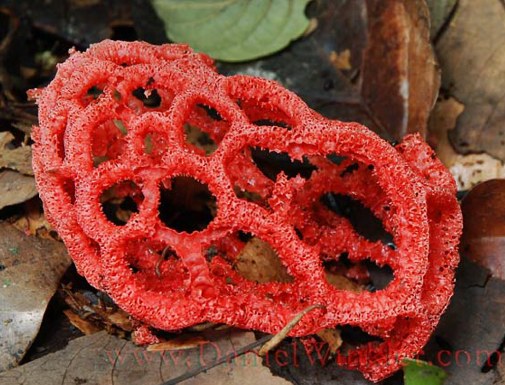 A Lattice Mushroom, Clathrus crispus is quite spectacular although this specimen is already a bit collapsed, probably it was in full splendor the night before. No gleba, the spore containing stinky substance, left on this fungal frame. The insects cleaned off the "tasty shit" to the last spore. We found it close to Jatun Sacha.
|
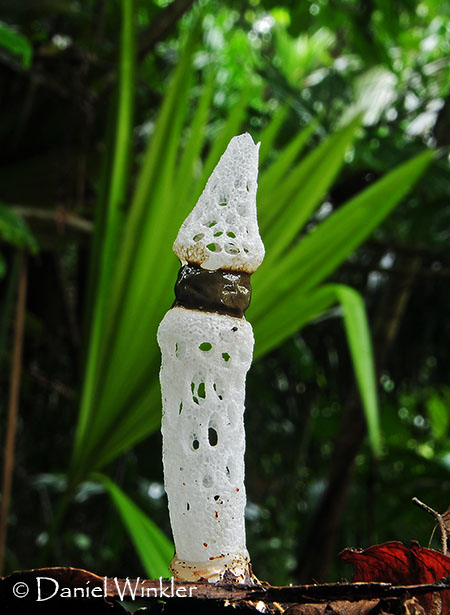 Staheliomyces cinctus, the rare and stunning Strangled stinkhorn is endemic to the neotropics. The Strangled stinkhorn is the sole member of the genus Staheliomyces. Cinctus literally means girded, belted, encircled.
Madidi NP, Bolivia, Feb. 2013
 Two stinkhorns, probably Phallus campanulatus we found in the Bolivian Amazon rain forest. This species was described for sandy soils further South, not confirmed for the Amazon yet. Madidi NP, Bolivia, Feb. 2013 |
|
Cordyceps - Caterpillar fungi and Allies
|
|
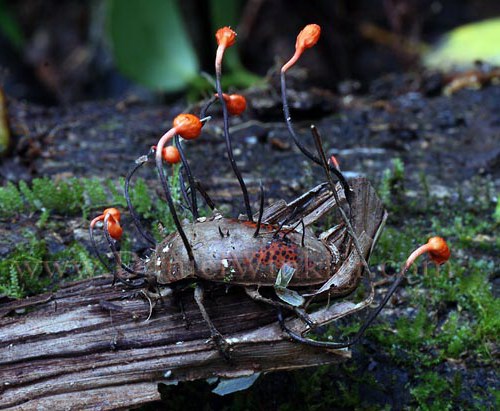 An Ophiocordyceps on a weevil with a whole bunch of fruiting bodies growing out of it that is quite similar to Ophiocordyceps curculionum. However DNA analyses by Joey Spatafora, OSU Corvallis, have shown that this is most likely a new species closely related to O. curculionum.
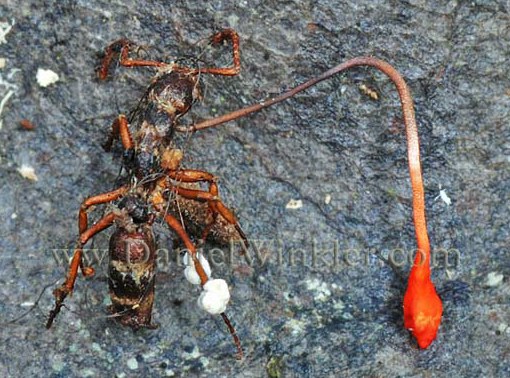 An ant probably infected by Ophiocordyceps australis, clearly visible is the red fertile tissue of the fruiting body. Note the white growths on the hind leg of the ant. It might be another parasitic fungus.
|
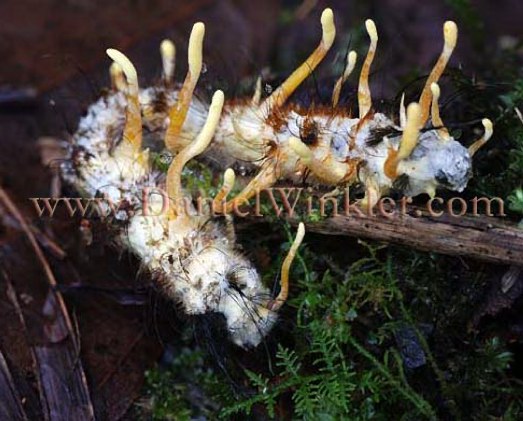 An Ophiocordyceps / Cordyceps I found in Mindo, sitting on top of an decaying, moss covered trunk. The site was in the cloud forest on the western slope of the Andes in Ecuador.
Link to other Cordyceps I found in Ecuador
on my blog.
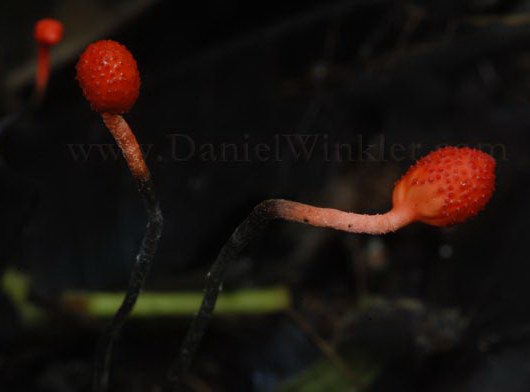 Close ups of the perithecia of Ophiocordyceps australis. What a great red these diminutive stromata display. The perithecia look close to maturity.
|
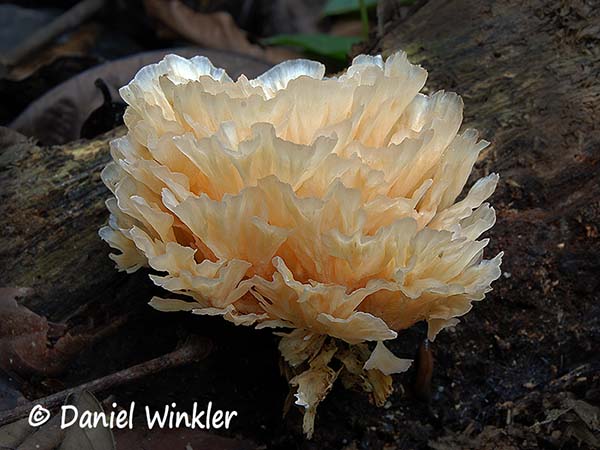 Not really sure what this beauty is exactly, but a member of the Podoscyphaceae, so possibly a Podoscypha sp.. At some point I was leaning towards Cotylidia or Hydnopolyporus sp. Its taste reminded us of a Sparassis, which it is absolutely not, but it had a much tougher, leathery flesh.
|
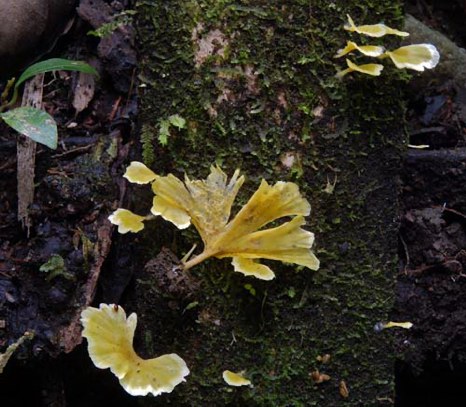 Cotylidia aurantiaca, the Golden Stalked Rosette is another toughish wood-decayer in the Hymenochaetales (Family: Repetobasidiaceae)
. |
|
The Amazon Blues
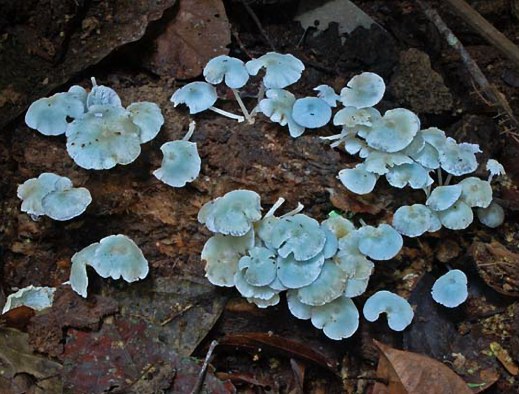 |
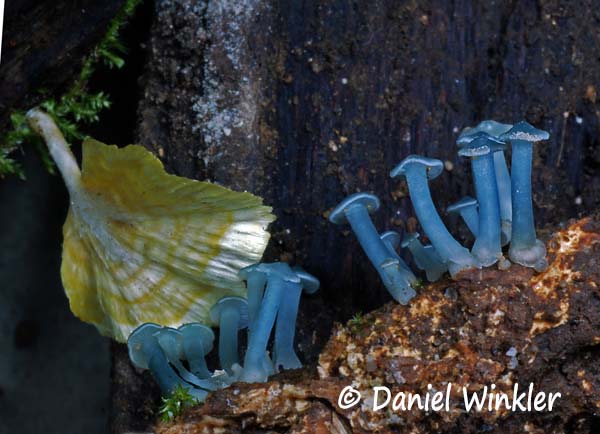 Tiny Clitocybula azurea with a Cotylidia aurantiaca.
Light blue Clitocybula azurea is a beautiful wood decomposer in the Tricholomaceae and according to Petersen and Læssøe "a very characteristic agaric in low to mid level wet forests of Ecuador"
|
 Indigo blue Leptonia in the Entolomataceae family. Larry Evans observed that they have "really cool angular spores".
|
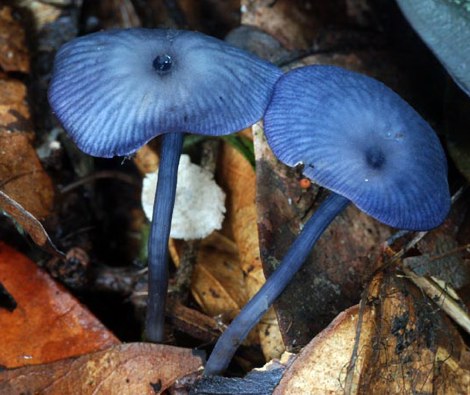 |
|
Some Rainforest Edibles
|
|
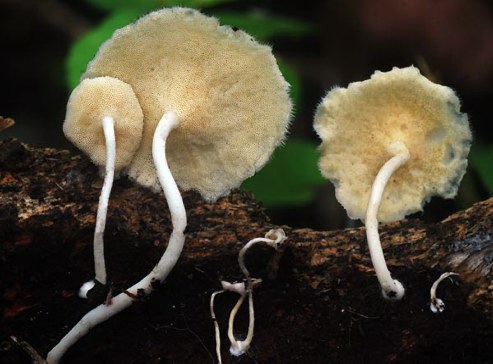 Lentinus (Polyporus) tricholoma, an edible tender polypore. 2020 Update: Apparently move dto Lentinus now, hence Lentinus tricholoma.
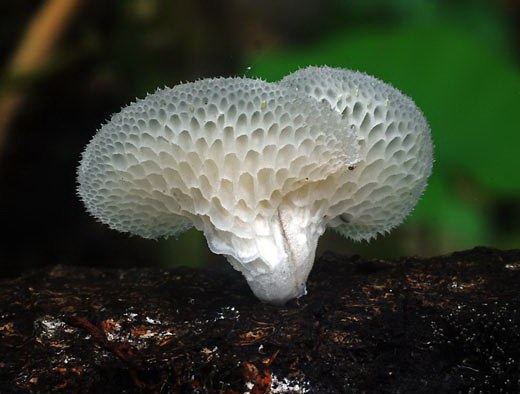 Favolus brasiliensis aka Polyporus tenuiculus is a soft-fleshed polypore that is widely eaten in the region.
|
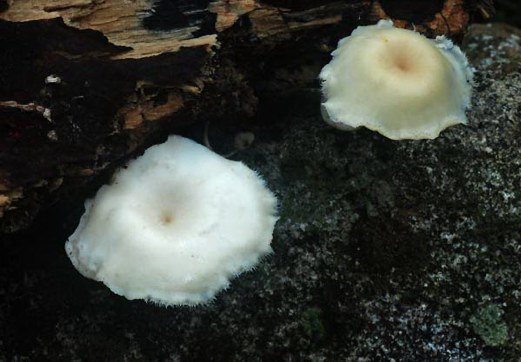 The hairs on the margin of this Polyporus make it a "tricholoma", meaning hairy.
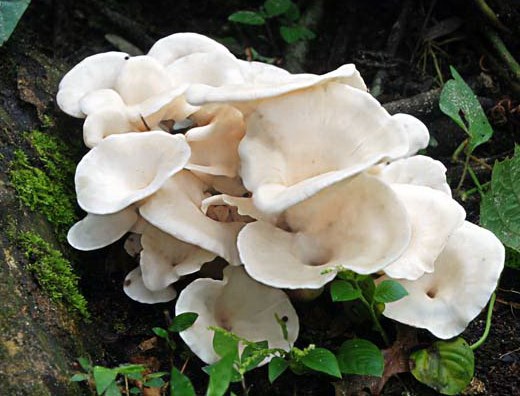 A nice cluster of Lentinus concavus, a good edible after sufficient cooking. It was formerly misclassified as an Pleurotus.
|
|
Boletales
|
|
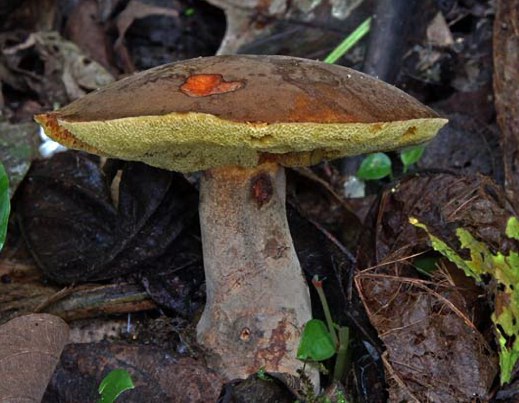 This Bolete was the only mushroom we found that looked like it could be a true Boletus. However it is a Phlebopus. Several species occur in the Amazon including Phlebopus beniensis and Ph. brasilensis, a region otherwise home to very few members of the Boletales. They grow on soil and seem sapropbic.
|
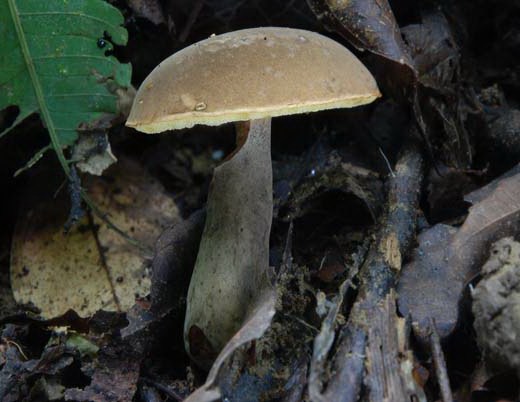 There are very few members of the Boletales in the rain forest, since most of them are ecto-mycorrhizal species and the majority of fungi are decomposers and parasites and not ecto-mycorrhizally root associated as most boletes are. It is edible, but we only saw very few specimen and they were larvae-riddled just like their northern brethren.
|
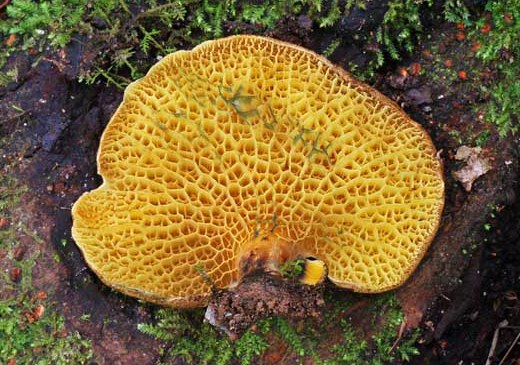 Boletinellus exiguus (Singer & Digilio) Watling, formerly Grodon exiguus was the only other member of the bolete family we came across. It grew on the base of trunks of living trees. It is associated with Andean Alder (Alnus acuminata), which grows along streams above 1500m. Thus, Gyrodon exiguus is not a low-land Amazon forest species.
|
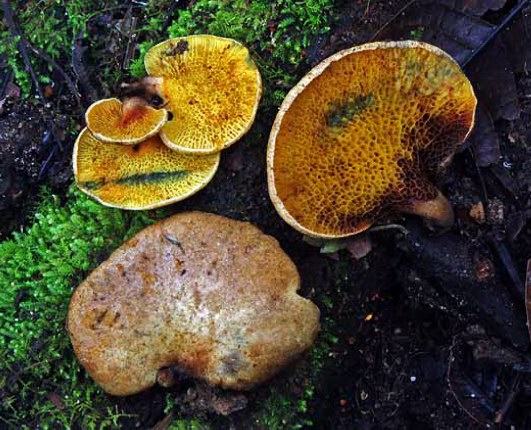 |
|
Cup Fungi in the Sarcoscyphaceae - Pezizales - Ascomycota
|
|
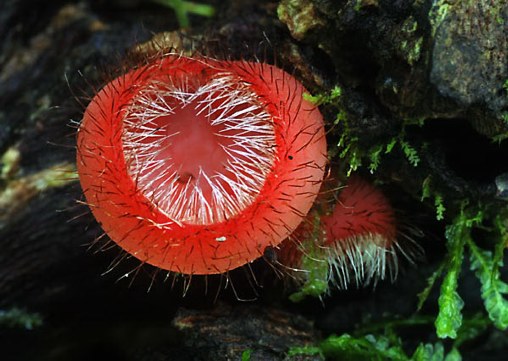 Cookeina tricholoma, a true beauty!
No mascara needed to bring out these eye-lashes.
But a frying pan will turn them nicely crunchy! I enjoyed eating all the here depicted Cookeina species!
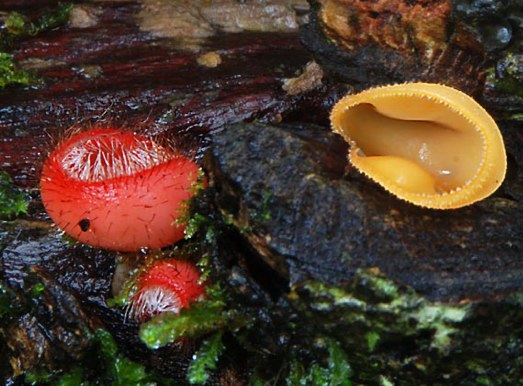 Cookeina tricholoma and Cookeina speciosa growing on the same piece of wood.
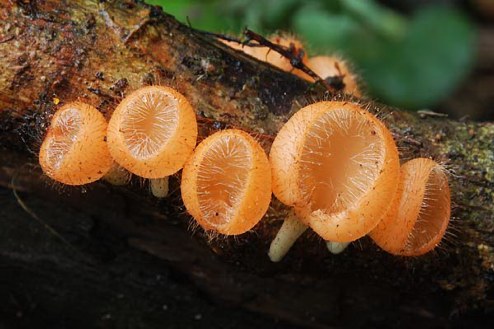 A row of Cookeina tricholoma growing out of a decaying branch.
|
 Cookeina speciosa
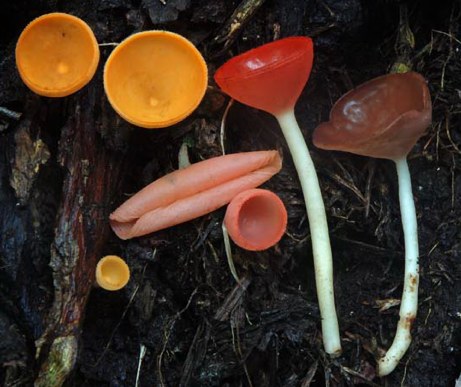 Cookeina speciosa in different stages of development. What a range of colors!
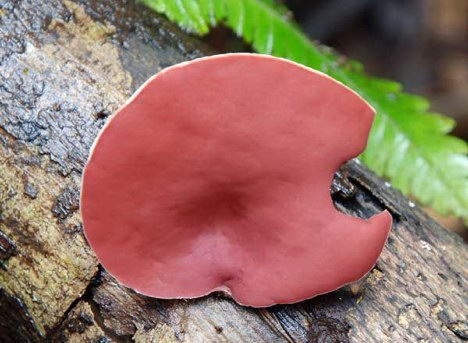 Phillipsia domingensis (Berk.) Berk., also a member of the Sarcoscyphaceae. A slug had taken a bite out of its cap.
|
|
Cool Conks
|
|
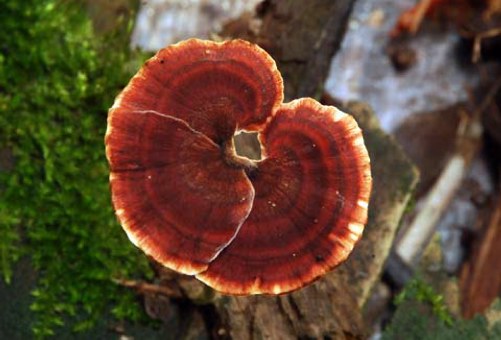 An Amauroderma belonging to a big genus, which is especially common in the tropics, in the Ganodermataceae family. In the Northern Hemisphere Lacquer conks (Ganoderma spp.) are the closest relatives, Ganoderma lucidum known as Ling Zhi or Reishi is a major myco-medicinal. Not surprisingly some Amauroderma species are regarded medicinal in Traditional Chinese Medicine and listed in "Fungi Pharmacopoeia"by Liu Bo & Bau Yun-sun, Oakland, 1980.
|
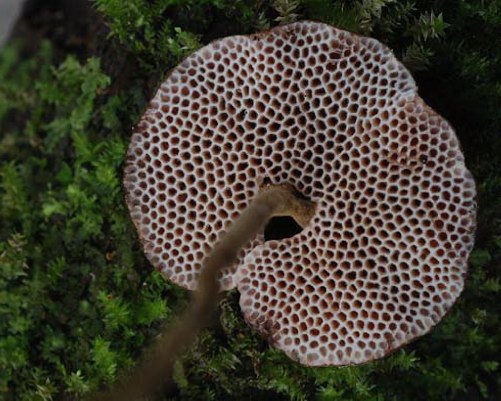 Looking at the pores of the same Amauroderma. The cap is probably 5 cm across.
|
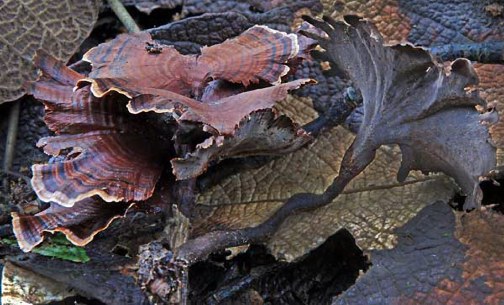 A branching Hymenochaete damaecornis Link ex Lev.
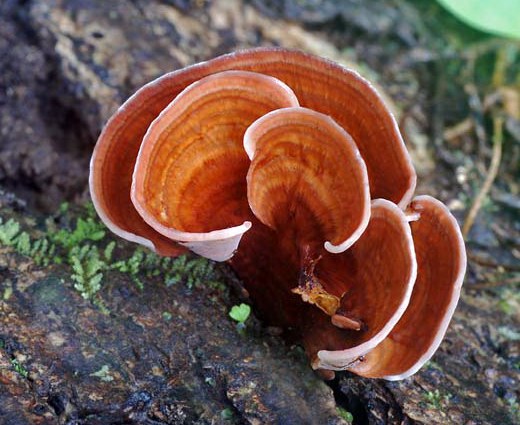 Hymenochaete luteobadia
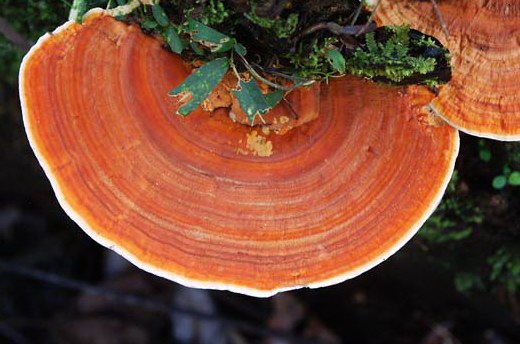 |
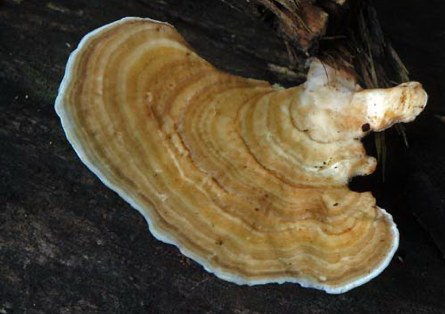 Trametes elegans, whose hymenium can be pored, labyrinthian or nicely gilled (see below).
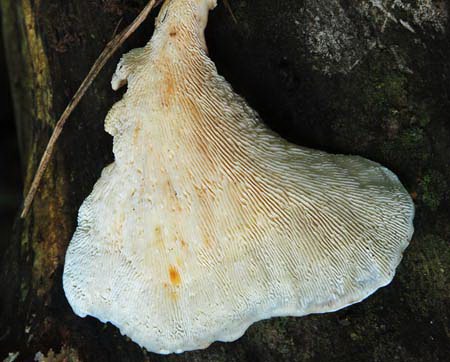 Seen in Lago Agrio
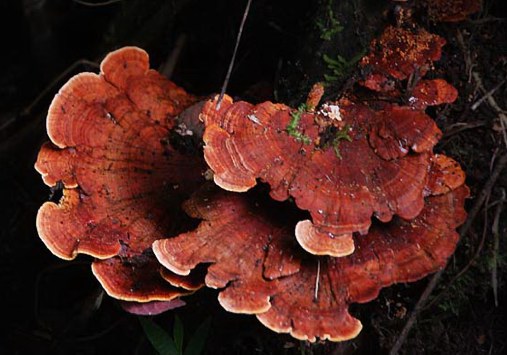 A big Hymenochaete, there are lots of these beautifully banded and relatively thin-fleshed, but sometimes big conks out in the rainforest.
|
|
Xylaria and Related Wood Decomposers
There seem to be hundreds of these blackish Ascomycetes.....
|
|
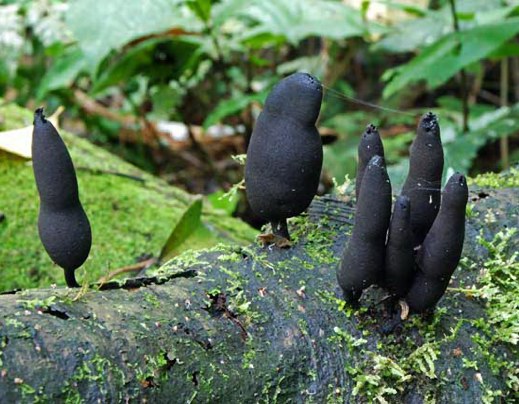 This big Xylaria (up to 15 cm tall) is looking quite similar to Dead Man's Finger, Xylaria polymorpha, but X. polymorpha is supposedly not distributed in South America. Quite similar looking to this specimen is Xylaria aenea, which is reported from Panama (Guzman and Piepenbring 2011. Los Hongos de Panama)
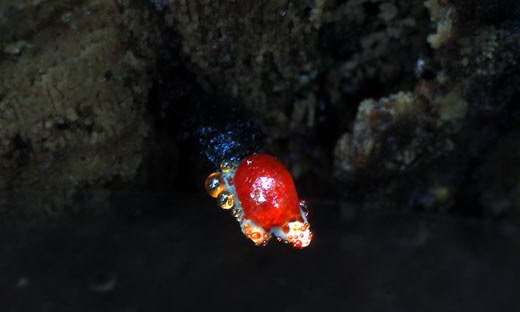 Xylarias do not have to be boring and black. Xylaria globosa puts on quite a show!
At least when it is emerging, with maturity (see below) it becomes all drab and round, sounds familiar, eh?
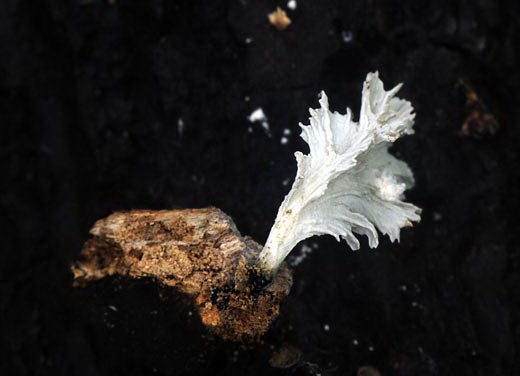 An anamorph of a Xylaria cubenisis, aka Xylocoremium flebilliforme.
A fungal organism that only produces conidia (or conidiospores) is known as an anamorph. Conidia are asexual spores, basically reproductive cell clones. Anamorphs do not grow stromata or fruiting bodies, only teleomorphs do. 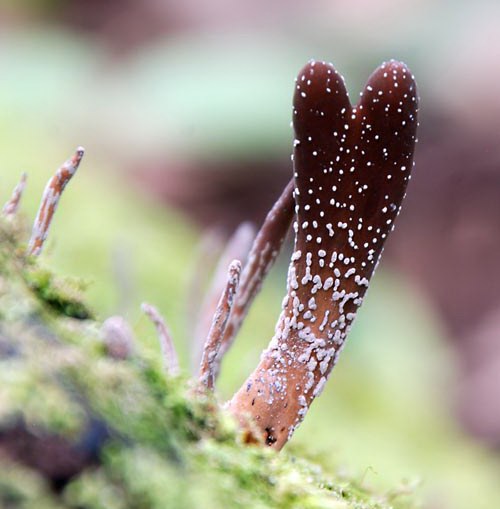 A very fresh Xylaria, although at first I wanted to see a Cordyceps.
 Unidentified Xylaria
|
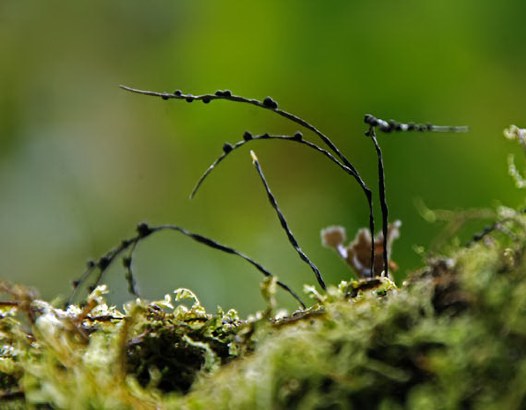 Xylaria chordiformis Lloyd
 Xylaria globosa, the Bleeding Xylaria, initializing growth.
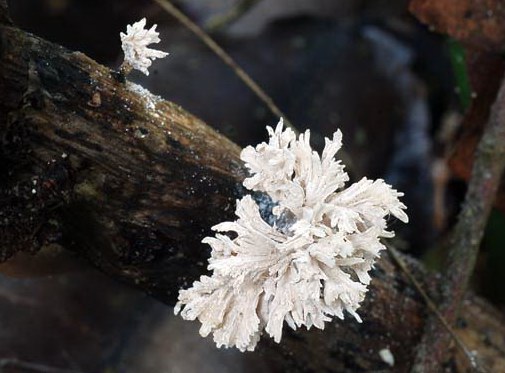 An anamorph of Xylaria cubensis still covered by lots of conidia-spores, asexually produced reproductive cells. It could be Xylocoremium flebilliforme.
 And another Xylariaceae with a very different structure.
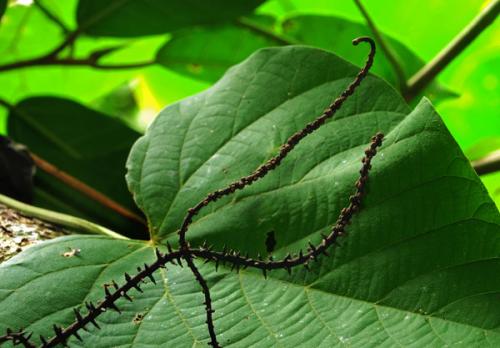 Thamnomyces chordalis is another Xylariaceae. it can grow to a length nearly 1 meter.
In Bolivia it is known as "Pelo de brujo", hair of the wizzard. 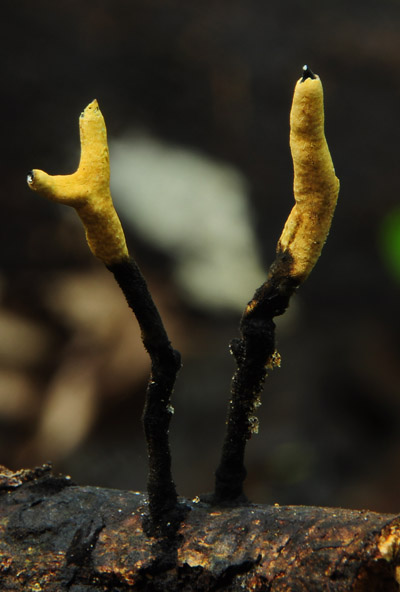 A strangely yellow colored Xylaria, that otherwise looks like associated with Xylaria comosa.
|
|
Puffballs, Earth Stars & Corals
|
|
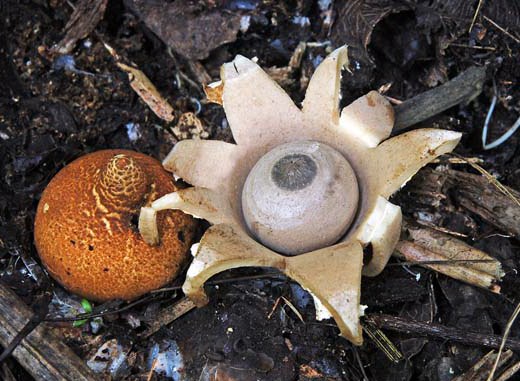 Two earth stars, one not open yet - Geastrum sp.
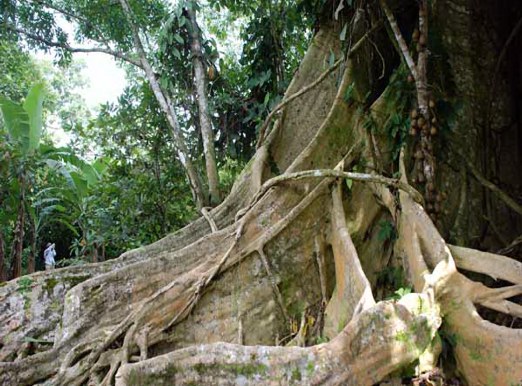 A buttressed root system. Some study showed that the same amount of buttressed and not buttressed trees came down in a hurricane, strange.
|
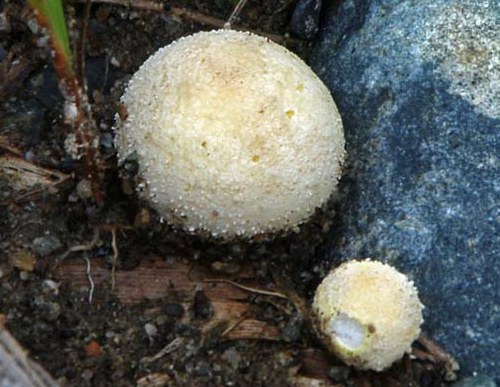 Vascellum sp. a puffball with papery separation tissue between stem base and spore mass.
 A coral encountered in Jatun Sacha Preserve, Napo, Feb. 2010 © Daniel Winkler
|
|
Agarics
|
|
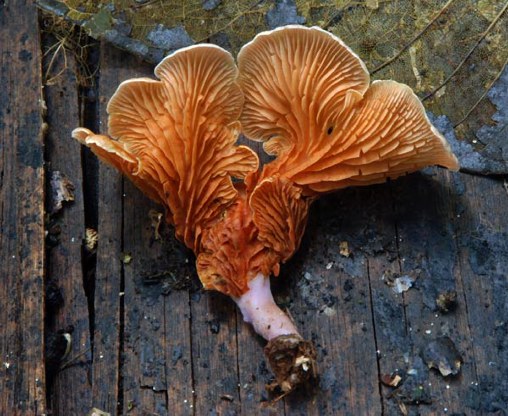 Pyyrhoglossum sp., a cortinarioid mushroom, growing on decaying wood! What great colors! Jatun Sacha Preserve, Napo, Feb. 2010 © Daniel Winkler
 Leucocoprinus brunneoluteus, formerly grouped with L. birnbaumii also known as Lepiota lutea or by the beautiful British name "Flowerpot Dapperling".
Well, that hat shape, slender stem and golden color is just dapper against the dark rain forest ground.
The jaunty Dapperling apparently made it out of the Amazon rainforest into hot houses and flower pots around the world.
Jatun Sacha Preserve, Napo, Feb. 2010 © Daniel Winkler
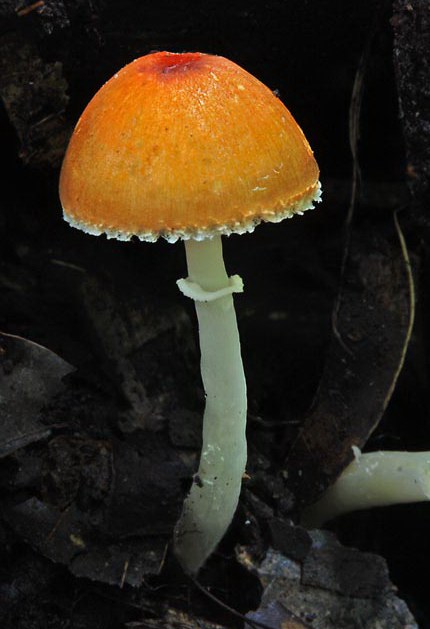 An unidentified lepiotaceous mushroom encountered near Lago Agrio.
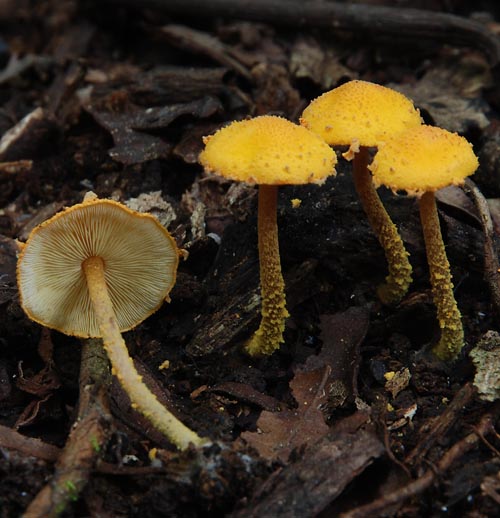 Cystoderma luteohemisphericum Dennis, a tiny, but scaly powdercap.
|
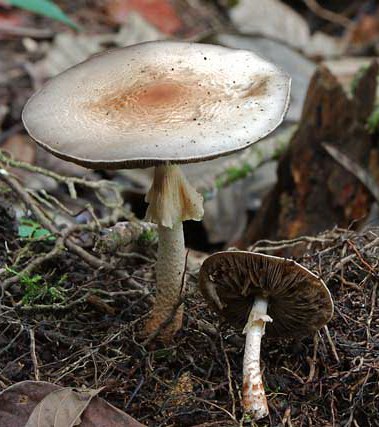 Agaricus rhoadsii ? Jatun Sacha Preserve, Napo, Feb. 2010 © Daniel Winkler
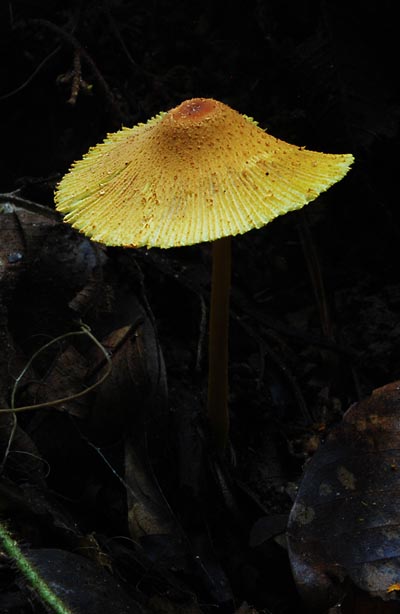 Leucocoprinus brunneoluteus
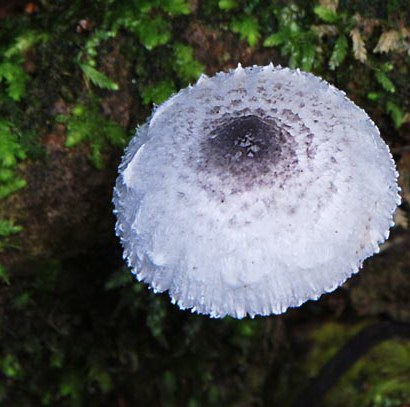 A Lepiota, reminded me of L. atrodisca, but probably something else, since Lepiota atrodisca is a North American species. There are many species of Lepiotas out in the rain forest.
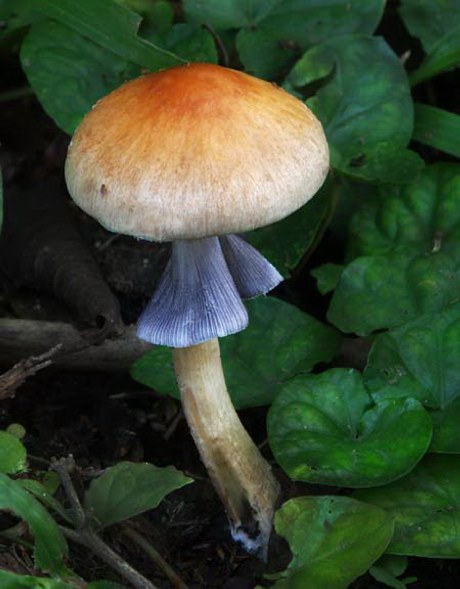 Gold cap (Psilocybe cubensis formerly also Stropharia cubensis) growing in horse manure. These dark spored agarics are common in tropical South America. Strangely, indigenous people do not seem to have had a use for them, although they discovered and used more psychotropic plants than any other culture on the globe.
|
|
Mind-boggling Multitude of Marasmius Mushrooms
thus it is pretty difficult to attach meaningful species names.....
|
|
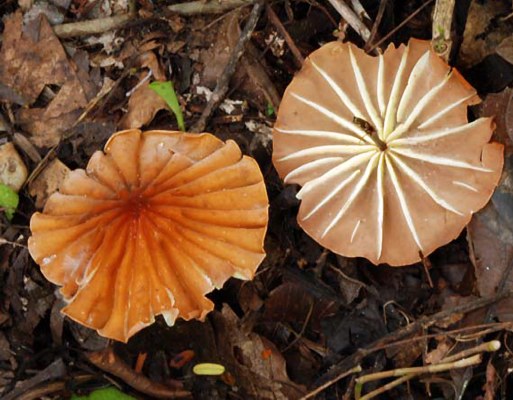 An orange brown pinwheel or parachute mushroom (probably Marasmius berteroi ) that lives of decomposing fallen leaves as many of its relatives in the rainforest.
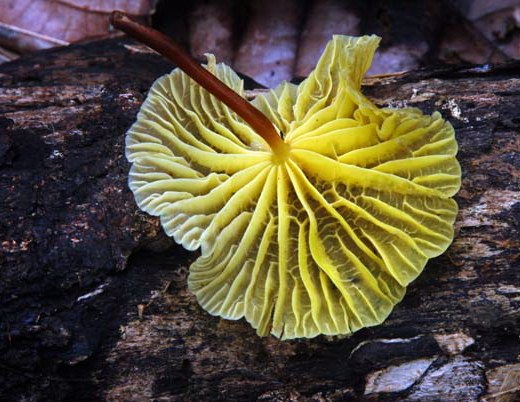 This Marasmius shows cross-veined gills, the interconnected secondary gills. I love the contrast between stem color and cap.
 This orange parachute mushroom, Marasmius cladophyllus shows even more profusely developed cross-veined gills, which is denoted in the species epithet cladophyllus - branch-gilled.
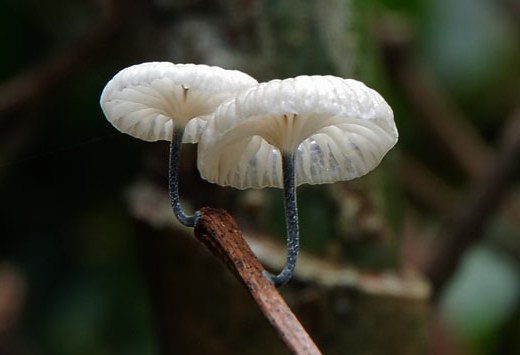 Marasmiellus nigripes a.k.a. Tetrapyrgos nigripes growing from the stem of a big leaf. There is no basal mycelium at the stem base, it connects directly to the substrate.
|
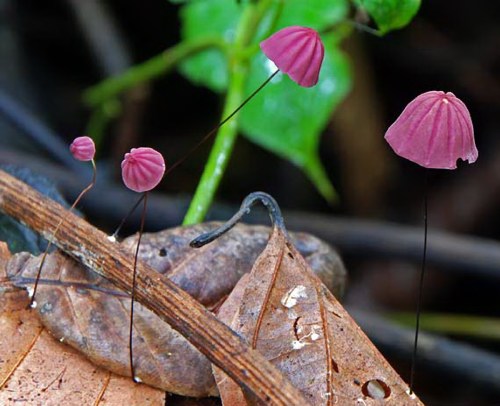 Tiny electric purple pinwheel mushrooms, Marasmius haematocephalus group, the Mauve Parachute. Ecuador, Feb. 2011 © Daniel Winkler
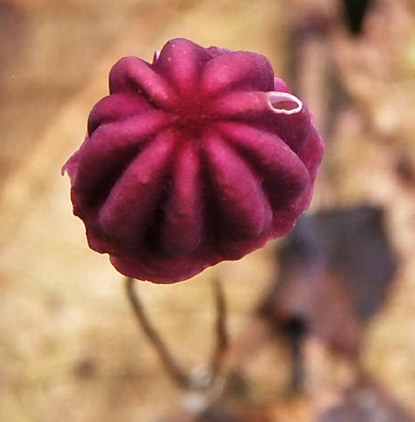 Marasmius haematocephalus group
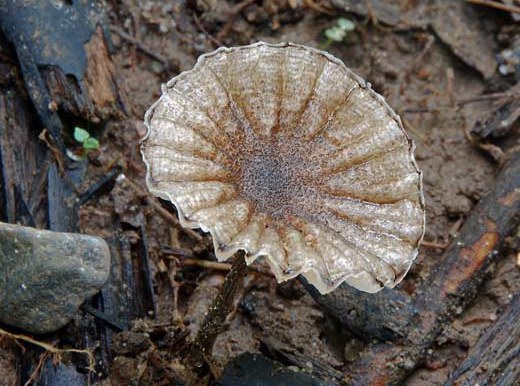 Probably Tetrapyrgos nigripes group. I like the rough surface of this little guy. Probably Tetrapyrgos nigripes group. I like the rough surface of this little guy.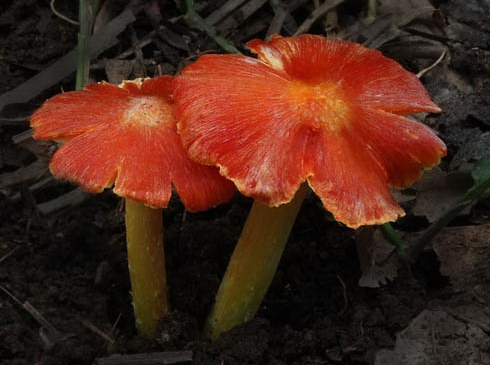 A Hygrocybe species
|
|
Wood Ears and Jellies
|
|
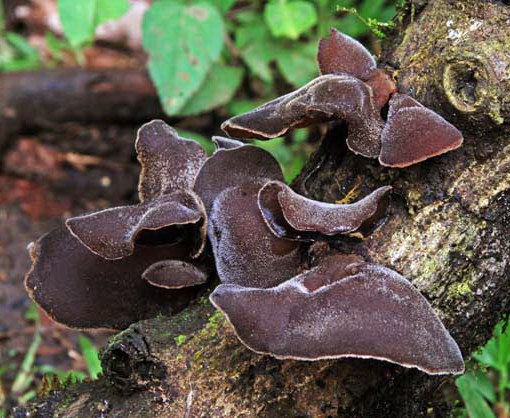 Auricularia cornea, one of three species of Wood ears we found.
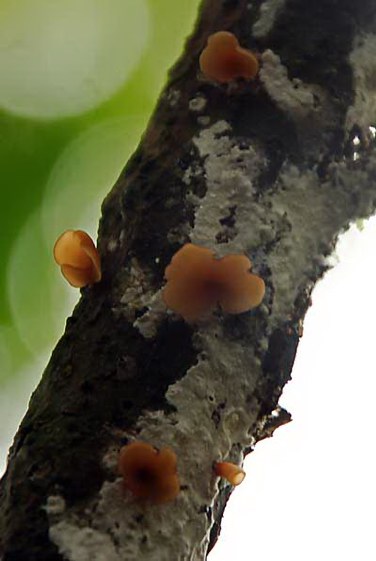 An Auricularia and a resupinate fungus growing out of a dead branch
|
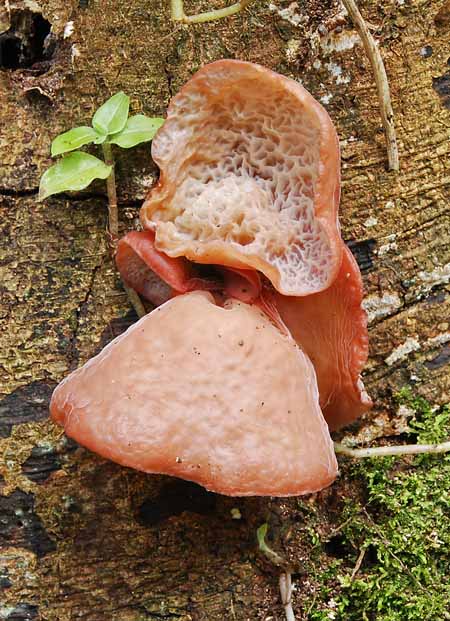 Auricularia delicata group with its beautiful reticulated underside.
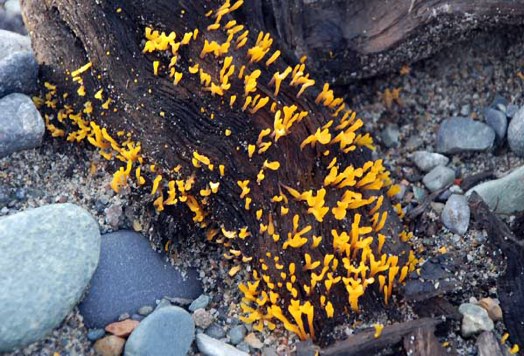 Fan-shaped Jelly (Dacryopinax spathularia) growing on rotting wood.
|
|
Flora
|
|
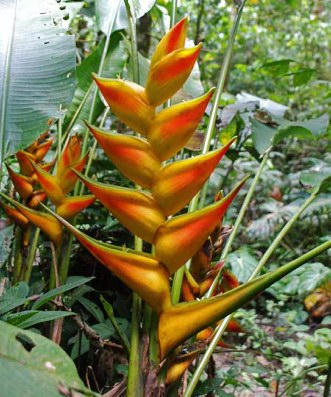 Supersized inflorescence of a Lobster Claw (Heliconia sp.). One of many Heliconia species we saw. Now Heliconia has its own family, the Heliconiaceae, formerly it was classified with the Banana (Musaceae) family. Ecuador, Feb. 2011. © Daniel Winkler
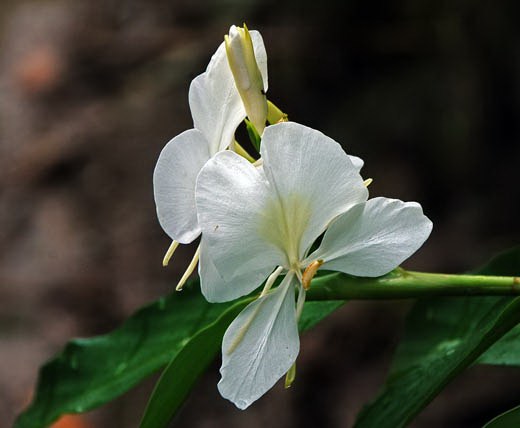 The fragrant White Ginger Lily or Butterfly Flower (Hedychium coronarium, Zingiberaceae), locally known as Lirio del muerto is not only enchanting, but also an invasive species introduced from the Himalayas.
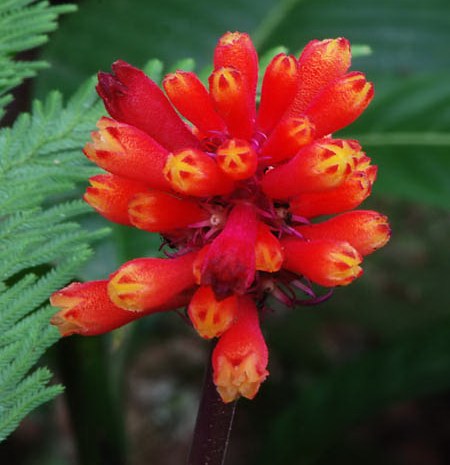 This bright red flower grew in the shady undergrowth of primary forest.
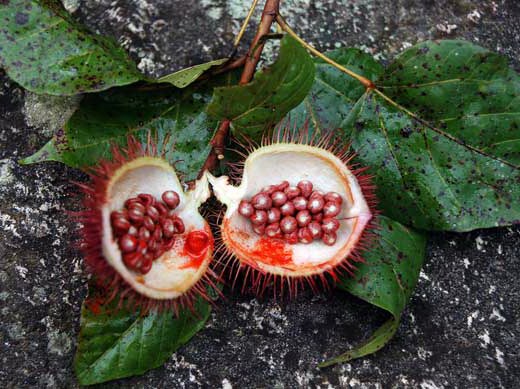
Achote, Bixa orellana, the source of red body paint used in the Amazon forest by many indigenous groups.
|
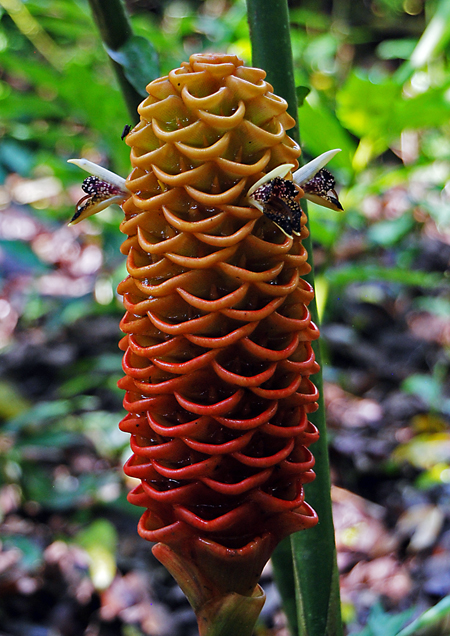 An inflorescence or cluster of flowers of Beehive Ginger, Zingiber spectabile (Zingiberaceae), an introduced ornamental from Southeast Asia. There are many other native wild ginger plants as well, but not as spectacular. Note the three flowers in bloom close to the top. And yes, the flower is structured so it can retain water.
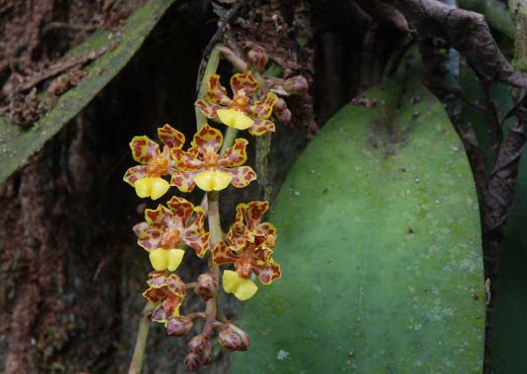 An Onicidum orchid growing epiphytically in Jatun Sacha Preserve, Napo, Feb. 2010 © Daniel Winkler
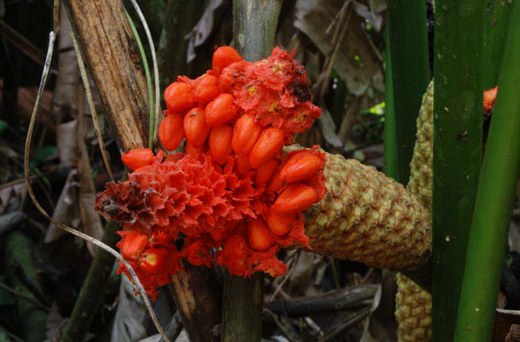 Gradually ripening fruits of a Panama Hat Palm - Carludovica palmata. Panama hats originate from Ecuador. It is named a Panama hat since these Ecuadorian hats were made for workers of the Panama canal a century back. It is still cultivate dfor its useful fibers. The Panama hat palm is not a true palm, but belongs to the Cyclanthaceae, Pandanales.
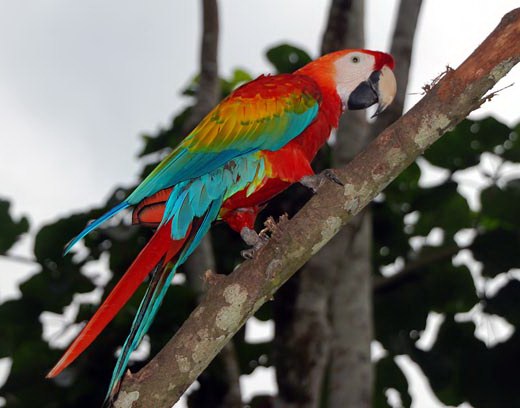 |
|
xx Fauna
|
|
 A White-necked Jacobin (Florisuga mellivora), one of many stunning beautiful hummingbirds.
 A purple dragon flies with translucent wings.
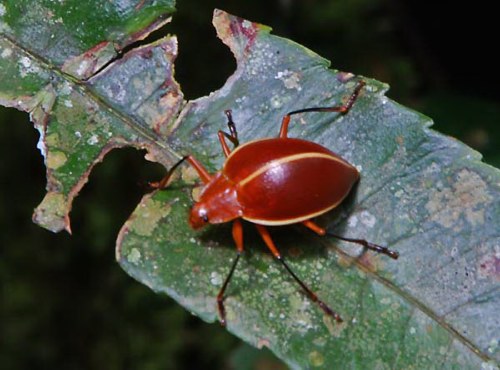 Cool bugs everywhere! I only photographed a few, already too many mushroom pictures to manage.
Link to my Amazonian rain forest Cordyceps
Link to awesome Fungi of Ecuador
by Danish mycologists Jens H. Petersen & Thomas Læssøe
|
 A tiny, we are talking less than inch small, Rufus-Brest Hermit - Glaucis hirsuta – a humming bird that builds nests under ferns or Heliconias above creeks.
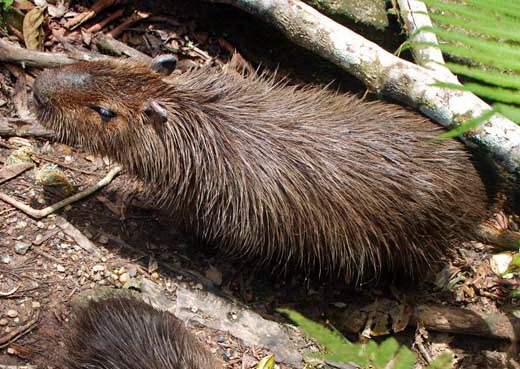 A Capybara (Hydrochaeris hydrochaeris), the world's largest rodent , likes to hang out near water in the rain forest.
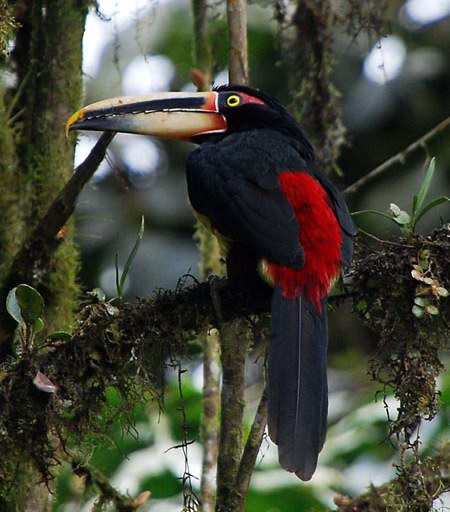 An Pale-Mandible Aracari (Pteroglossus erythropygius), a small Toucan seen in Mindo.
|
The cespitose cluster of Lentinus concavus, an edible and tasty mushroom. This wood decaying fungus shows promise as an oil degrading fungus as well. On the left are the white caps of Lentinus concavus depicted. Seen in Chalalan, Bolivian Amazon, 2- 2014 © D. Winkler
|
|||
|
Oil pollution in the jungle in Ecuador
|
|||
|
|||
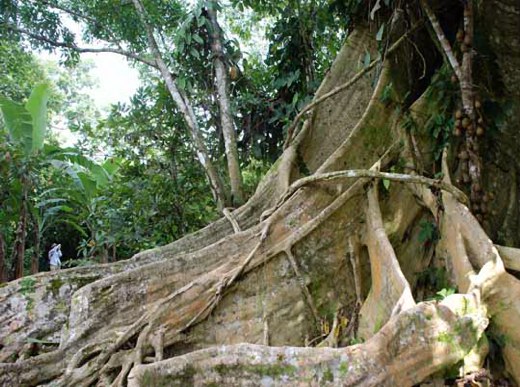 A buttressed root system. Some study showed that the same amount of buttressed and not buttressed trees came down in a hurricane, strange.
|
Last changes 5-31-2023 Page first uploaded Oct. 26, 2010 Link to awesome Fungi of Ecuador
by Danish mycologists Jens H. Petersen & Thomas Læssøe
Link to their 40 page pdf full of great mushroom images. The text is in Danish, but all images have also English subtitles.
|
||

